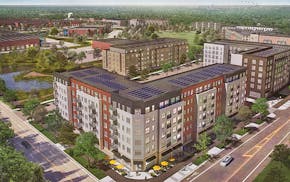Opinion editor's note: Star Tribune Opinion publishes letters from readers online and in print each day. To contribute, click here.
•••
Ethanol production and use in Minnesota simply does not live up to its promise ("Ethanol movement on shakier ground," April 7). Is it good for producers and manufacturers? Absolutely. Is it good for the environment? Definitely not. If you look at the inputs, they are all based on petroleum usage. Nitrogen, which is created using natural gas. Fuels for planting, harvesting and trucking. Petroleum-based. Pesticides. Petroleum-based.
One needs to look no further than cornfields in Minnesota. Densely packed. Heavily fertilized and sprayed with pesticides. Topsoil missing from fields because of fall tilling (bare ground) and wind erosion. This also means more nitrogen applied.
Ethanol at a much higher rate does affect performance and mileage. Yet it was priced to compete with gas. Ethanol plants themselves are larger emitters of carbon. So now industry wants to build carbon pipelines from ethanol plants to (theoretically) safely store carbon in the Dakotas. Not surprisingly U.S. Department of Agriculture Secretary Tom Vilsack's son is a big player in this pipeline plan.
Lastly, water usage. How much water does it take to produce a gallon of ethanol? How much water continues to be contaminated by nitrites? And why should we support ethanol aviation fuel when the myriad problems created are nowhere near being resolved?
Dan Wilm, Pequot Lakes, Minn.
•••
Alongside the biofuel leaders at Growth Energy, our team at the Minnesota Service Station & Convenience Store Association (MSSA) shared the urgent need for an emergency waiver to extend summertime sales of E15 with our champions on Capitol Hill. We thanked U.S. Rep. Angie Craig's team for supporting the biofuel industry and encouraged them to urge President Joe Biden to act swiftly and grant an E15 waiver.
E15 — a 15% biofuel blend — saved drivers an average of 10-30 cents per gallon over the past two summers, with some locations offering up to $1 off per gallon. However, due to outdated federal regulations on the summertime sale of this affordable fuel, drivers could soon lose access to these cost savings if the Biden administration does not act soon.
In Minnesota alone, sales of E15 hit more than 127 million gallons last year — a record high, and drivers appreciate Minnesota fueling retailers offering homegrown fuels such as E15 offering a low-cost option to fuel their commutes, road trips and beyond.
For two summers, Biden has granted an emergency waiver, delivering cost savings to American drivers. This summer should be no different — motorists should not be denied access to low-cost options at the pump while supporting our local farming communities!
Lance Klatt, Little Canada
The writer is Minnesota Service Station & Convenience Store Association executive director.
SYNTHETIC TURF
Real plants for real habitats
I disagree with a bill in the Minnesota Legislature about synthetic turf (HF 3705/SF 3869).
Synthetic turf has been framed as a sustainable solution for dealing with the climate crisis, drought and drainage issues. Unfortunately, many want to believe in this easy but expensive solution and believe without evidence that it is a sustainable practice. This is greenwashing and a false solution for helping our climate crisis. Synthetic turf is made of plastic. It has all the terrible side effects of plastic pollution. It breaks down in the sun and breaks down with use. It leaches toxic chemicals into our water and breaks down into microfibers. Synthetic turf is not healthy for children, pets, wildlife or adults to recreate on. It is not a sensible solution for a green lawn.
If plastic were a country, it would be the fifth-largest emitter of greenhouse gases in the world. We shouldn't be encouraging the use of more plastic. We should be reducing our plastic use, not increasing it.
Synthetic turf is terrible at managing stormwater runoff. Even if it is permeable, the water will run right under it and cause erosion as it finds a muddy path to the nearest waterway. Deep rooted plants are the master of absorbing runoff and holding the soil. They are a proven solution.
The state of Minnesota is putting lots of money into bee lawns. Let's pivot to them in times of drought. Bee lawns help pollinators, improve water quality and work for the healthy communities the public wants. Bee lawns are real, not fake. They are a low-maintenance and sustainable solution, and bee lawns can be adjusted and planted for everyone's needs.
Becky Wardell Gaertner, Minneapolis
PRODUCE WASTE
More than one method of disposal
The data presented in the article "Can produce and plastic split up?" (April 5) gave a false impression of doom for consumers' good commitment to produce consumption. It may, in fact, be that unused produce is bad for our garbage environment. However, plastic is not the only tool against produce "waste." Composting produce keeps all of it from our landfills; it becomes sustainable garbage as healthy fertilizer. Many curbside programs (including mine, for a multiunit building) have a container for household compostables.
Using that compost container means less wasted produce.
Sheila Martin, Golden Valley
TRAFFIC
An appealing change for I-94
Mark me down as a huge fan of the boulevard idea for the Interstate 94 corridor between St. Paul and Minneapolis ("New direction for I-94?" April 4). The "serious" people writing in are saying not to consider this vision of what could be and to continue with the current design of a highway between the downtowns. But this is a once-in-a-generation opportunity for a dramatic improvement to this part of our community that has suffered disproportionately the effects of this highway in terms of environmental pollution, health disparities, crime, lower equity and on and on. The study from the advocacy group Our Streets Minneapolis shows local residents' average trips on the highway are around 5 minutes, which means removing it wouldn't impact them as negatively as all the "serious" people want to claim. I would expect the Minnesota Department of Transportation to independently validate this data before drawing conclusions but, when considered along with all the benefits that would accrue to the residents of these neighborhoods and the metropolitan area at large, the boulevard concept is an exciting way forward.
Jay Schiltz, Minneapolis
•••
"Traffic evaporation"? ("Bryant Av. bike lane called one of the best," April 8.)
That has got to be the worst catchphrase I've heard through all of the bike-lane discussions I've read these past few years.
The concept is ludicrous. Traffic doesn't evaporate; it moves to other streets and clogs them.
I'm a huge fan of more transit options and fewer cars. But really, don't cloud the issue with feel-good, nonsensical slogans.
Chas Jensen, St. Paul
E-BIKES
Subsidizing my laziness
In the last session the Minnesota Legislature passed a bunch of bills to address climate change. Among them was an electric vehicle rebate program that offers a rebate of up to $2,500 toward the purchase of a new electric car or truck. This is a sensible program to save energy, lessen emissions and wean people off their dependence on fossil-fuel type vehicles.
During the same session another rebate program was passed that offers a rebate of 50% to 75%, up to $1,500, off the cost of a new e-bike. So with this program the Legislature is encouraging us to use more energy, increase emissions and wean lazy people, like me, off my dependence on exercise. I am fairly old but I don't think I will ever be old enough to totally understand governmental logic.
Bruce Lemke, Orono

Will Columbia protesters achieve their goals?

The student-led protests aren't perfect. That doesn't mean they're not right.

